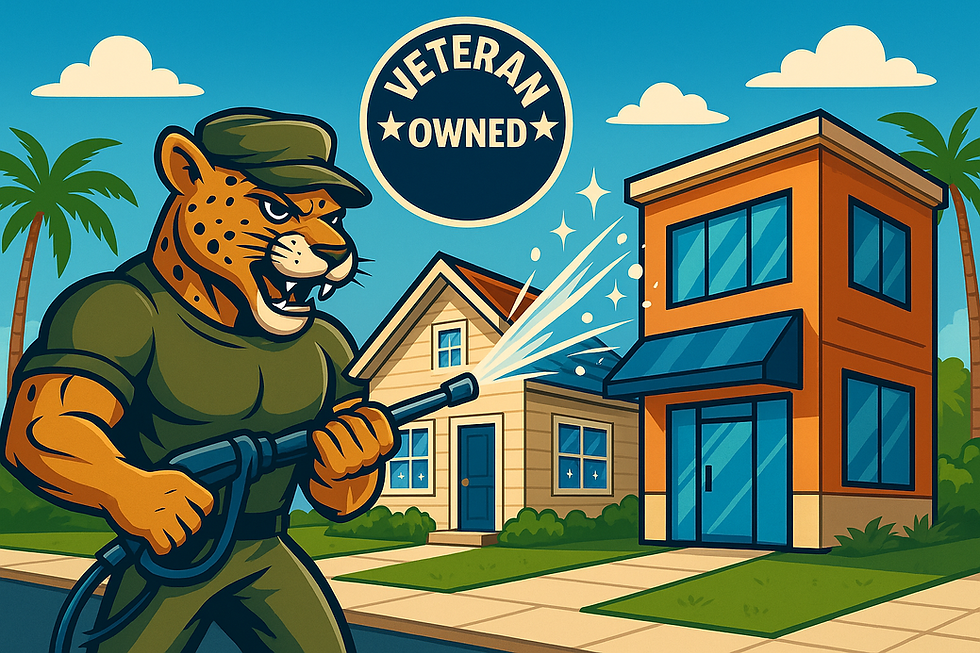DIY Soft Washing Tips for Homeowners in Jacksonville, FL
- Marcus Digrado
- Jun 6
- 4 min read
Keeping your home’s exterior clean is not just about aesthetics; it plays a crucial role in maintaining property value and health. Many homeowners opt for professional services, but taking on a DIY project can save money and foster a sense of accomplishment. One popular method that many Florida residents are talking about is soft washing. This process is especially relevant for those in Jacksonville, where humidity and heat contribute to the growth of mold and algae. In this post, we will explore DIY soft washing techniques and why they matter for Jacksonville homeowners.
What is Soft Washing?
Soft washing is a low-pressure cleaning method that uses biodegradable solutions to eliminate dirt, mold, algae, and other contaminants without damaging delicate surfaces. In contrast to traditional pressure washing, soft washing effectively cleans surfaces like roofs, siding, and decks while preserving their integrity.
For example, a study found that homes treated with soft washing solutions can maintain their cleanliness for up to six months longer than those that undergo regular pressure washing. This makes the gentle approach particularly beneficial for Jacksonville homes that endure heavy rainfall and humidity.
The Importance of Soft Washing for Homeowners
Homeowners in Jacksonville should prioritize soft washing for several key reasons:
Preserving Property Value: Regular soft washing can help maintain your home’s visual appeal, preventing stains that could decrease property value. Studies show that homes with clean exteriors can sell for up to 10% more than those with neglected surfaces.
Health Considerations: Mold, mildew, and algae can affect air quality. In fact, about 30% of people with allergies may experience symptoms due to mold exposure. By soft washing your home, you ensure a healthier environment for your loved ones.
Cost-Effective Maintenance: Learning to soft wash can save you hundreds each year. While hiring a professional may cost $300-$800 per session, DIY methods can typically be done for less than $50, depending on the size of your home.
Environmental Friendliness: Many soft washing solutions are eco-friendly and biodegradable, allowing you to clean your home while protecting local ecosystems. For instance, using a 100% biodegradable cleaner can help avoid harm to nearby plants and wildlife.
Essential Tools and Materials for DIY Soft Washing
Before you start soft washing, gather these essential tools and materials:
Soft Wash System: Consider purchasing or renting a soft wash system that typically includes a pump, hose, and nozzle tailored for low-pressure cleaning. Systems can range from $100 to $400 based on features.
Cleaning Solutions: Create a mixture of biodegradable detergent, bleach, and water. A common ratio is about 1 part bleach to 3 parts water. This solution is powerful against mold but gentle enough for surfaces.
Protective Gear: Always prioritize safety. Wear gloves, goggles, and a mask when handling chemicals.
Extension Ladder: To access high areas, especially roofs and upper surfaces, make sure your ladder is stable and rated for your weight.
By preparing the right tools, you not only enhance safety but also make the cleaning process smoother.

Soft wash done by Big Jags Exterior Services on coquina in Fernandina beach, florida.
Steps to Soft Wash Your Home
Step 1: Prepare the Area
Clear the area around your home by moving furniture, plants, or decorations that could be affected by cleaning solutions. This preparation safeguards your landscape and prevents damage.
Step 2: Protect Plants and Surfaces
Cover any nearby plants, flowers, and delicate surfaces to shield them from your cleaning solutions. Tarps or plastic sheets work well as protective barriers to minimize overspray.
Step 3: Mix the Cleaning Solution
In a suitable tank, mix your cleaning solution as per the manufacturer’s instructions. The common mixture is 1 part bleach to 4 parts water combined with detergent. Stir thoroughly for even distribution.
Step 4: Apply the Solution
Using your soft wash system, apply the solution to a small section of your home, starting from the bottom and moving upward. This technique prevents dirty water from running down onto cleaned areas.
Step 5: Allow it to Sit
Let the solution sit for 1-3 minutes. This waiting period is crucial, as it allows the chemicals to lift grime and stains effectively. Avoid letting the solution dry completely.
Step 6: Rinse Thoroughly
After the waiting period, rinse the area thoroughly, starting from the top and moving downwards. This ensures all residues are washed away. A garden hose with a spray nozzle provides the best results for rinsing.
Step 7: Inspect and Repeat if Necessary
Inspect the cleaned area after rinsing. If you see any leftover stains, reapply the cleaning solution and rinse again.
When to Soft Wash
The frequency of soft washing depends on factors like climate, location, and materials used in your home’s construction. Generally, soft washing every 12-18 months is recommended. However, due to Jacksonville’s humid environment, consider soft washing every 6-12 months, especially after summer rains when mold growth is more likely.
Safety Considerations
While DIY soft washing can be fulfilling, safety remains crucial. Always wear the appropriate protective gear and avoid working alone when using ladders. If you feel uncomfortable tackling high areas, consulting a professional is a smart choice.
Final Thoughts
DIY soft washing provides a fulfilling way for Jacksonville homeowners to maintain their home's exterior while ensuring health and property value. This gentle method effectively combats the growth of mold and algae. With the right tools, safety precautions, and a bit of practice, you can enhance your home’s curb appeal and reduce cleaning costs. Embrace the project—your home will appreciate it, and so will your wallet!





Comentários